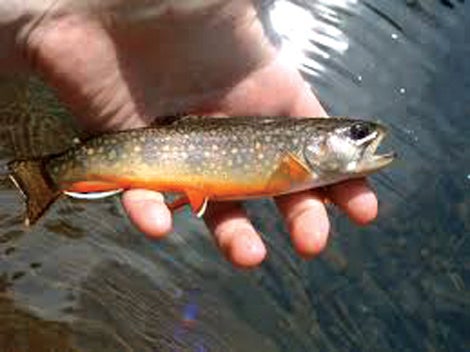East Tennessee Outdoors: Brook Trout
Published 6:00 am Monday, July 8, 2019

- Photo Contributed The brook trout will usually only grow to about 4-8 inches in this area, but they are a joy to catch.
BY DANNY BLEVINS
STAR CORRESPONDENT
Quick Quiz! How many trout are native to this area? Believe it or not, the answer is zero. There are no trout native to this area.
Yes, lake trout, rainbow trout, and brown trout all call this area home, but game officials introduced most of these species during the last 100 years.
The only native fish that is scientifically close to being a trout is the brook trout or speckled trout as East Tennessee locals call them. This fish is not a member of the trout family but is a member of the char family, along with lake trout, Dolly Varden, and several other fish.
Whether they are a trout or not, brook trout can be a delightful fish to catch.
They are only found in the highest tributaries of the mountains, back in the mountain laurel thickets and high in the winding hollows.
Most of these fish do not grow larger than five or six inches and catching one that is eight or ten inches is a real trophy.
The largest brook I have ever caught was a fish that was 11 inches long, but I did watch as my father snagged a 12-inch trophy out of a creek that was about four feet wide one day.
He instantly became my hero.
These little fish live in the high mountain streams because they serve as bait fish for most other trout.
A rainbow or brown trout will eat them if they can catch them and this has caused these fish to move to areas where predator fish cannot go.
I know of two small streams that are high in the hollows of the Roan.
One of the streams will produce rainbow trout that are six to ten inches in length.
Just a short walk across a ridge and you will find a similar stream that has nothing in it except brook trout.
Simply put, the rainbow had eaten all of the brook trout from one stream but the water was too shallow for them to go up the other stream.
Over the years, predator fish and overfishing have caused the population of these fish to be decimated.
These fish are being protected in some streams by the building of artificial barriers that stop the larger rainbow and brown trout from getting to the brook.
This has helped the brook population bounce back in some areas.
However, another way these fish can make a comeback in these mountain streams is by catch and release.
I remember growing up 40 years ago when we would go to the mountain streams and catch dozens of these fish to eat.
If my memory is correct, one day we caught a total of 64 fish and kept every one of them.
Nothing was wasted and all of these fish were eaten, but a fish population such as the brook cannot sustain such fishing numbers.
If you want to fish for these little beauties, they are a joy to catch and they probably fight better than any other trout, especially considering their size.
Catch them with your favorite fly or spinner, but think small. I mean really small.
For spinners, use 1/64 oz or 1/32 oz, and if you are using flies, a size 20 or 22 is still not too small.
If you are using bait, use your garden variety red worms on a size 8 or 10 hook, but remember you will probably have to keep what you catch because most of these fish will swallow the bait.
Currently, the Tennessee Wildlife Resources Agency regulations state that only seven trout can be caught and kept in the same day, and there is no size limit.
Consult the TWRA 2019 Fishing Guide for more information on these fish.
The first fish I ever caught was a brook trout, so they have a special place in my life.
Get your favorite ultra-light spinning rod and reel and your favorite spinner and go catch a few. I guarantee it will be an adventure.





